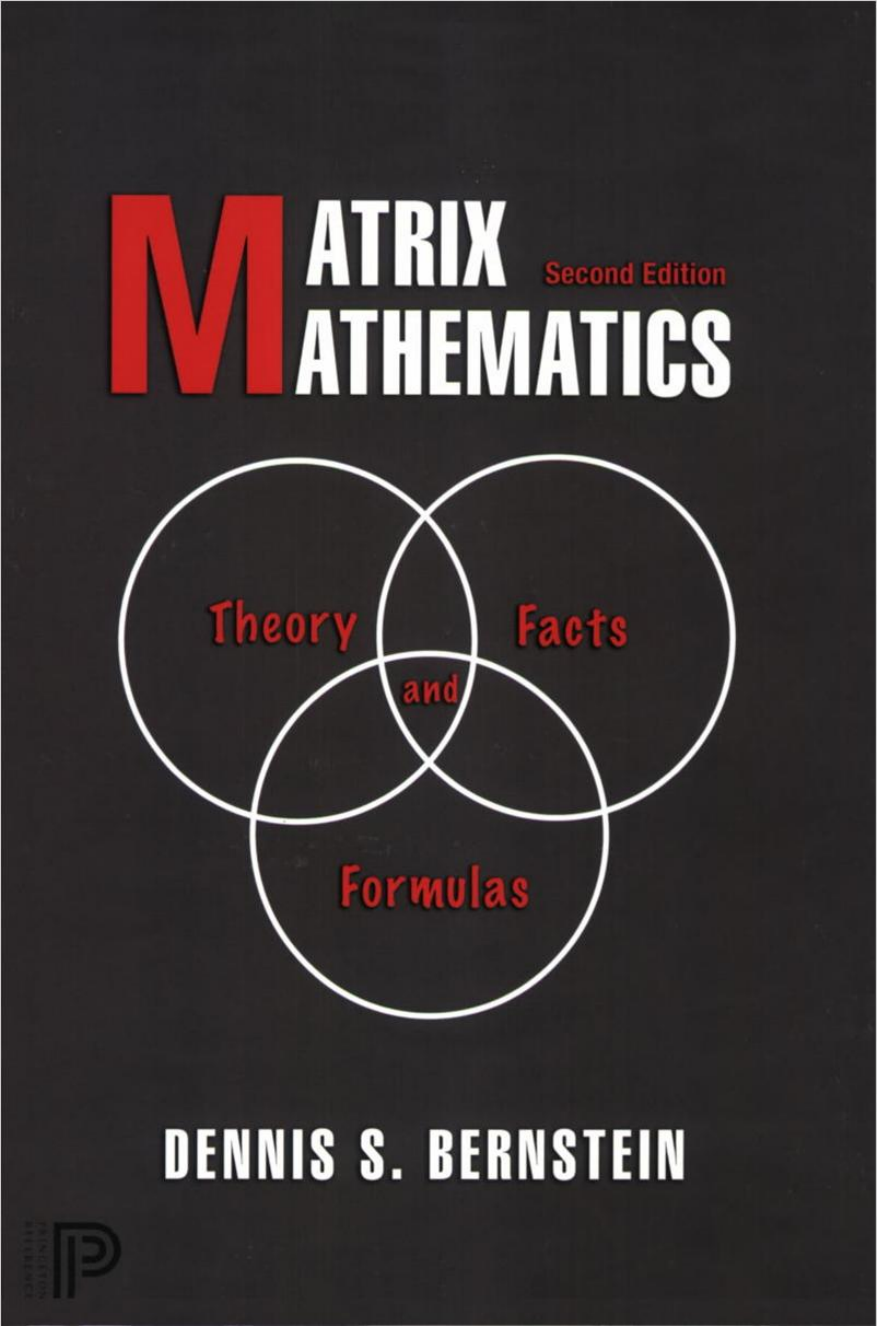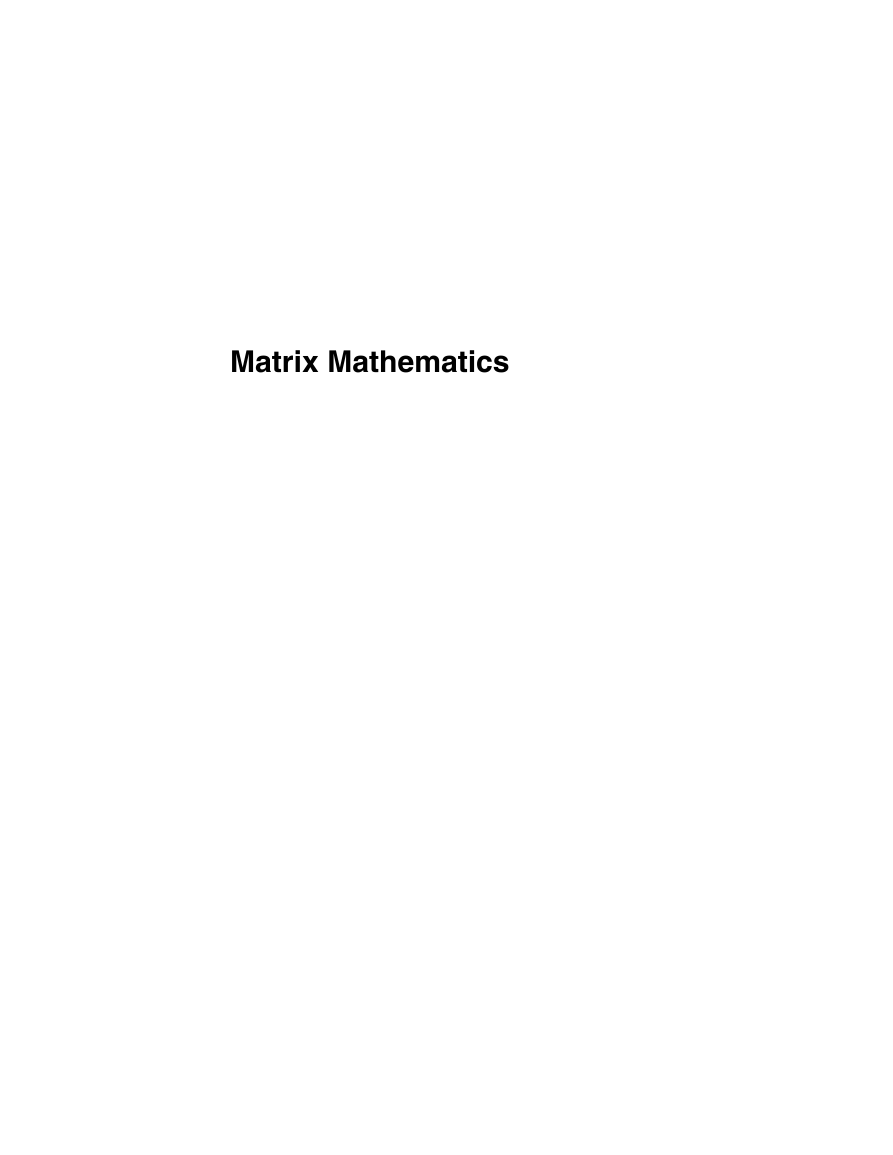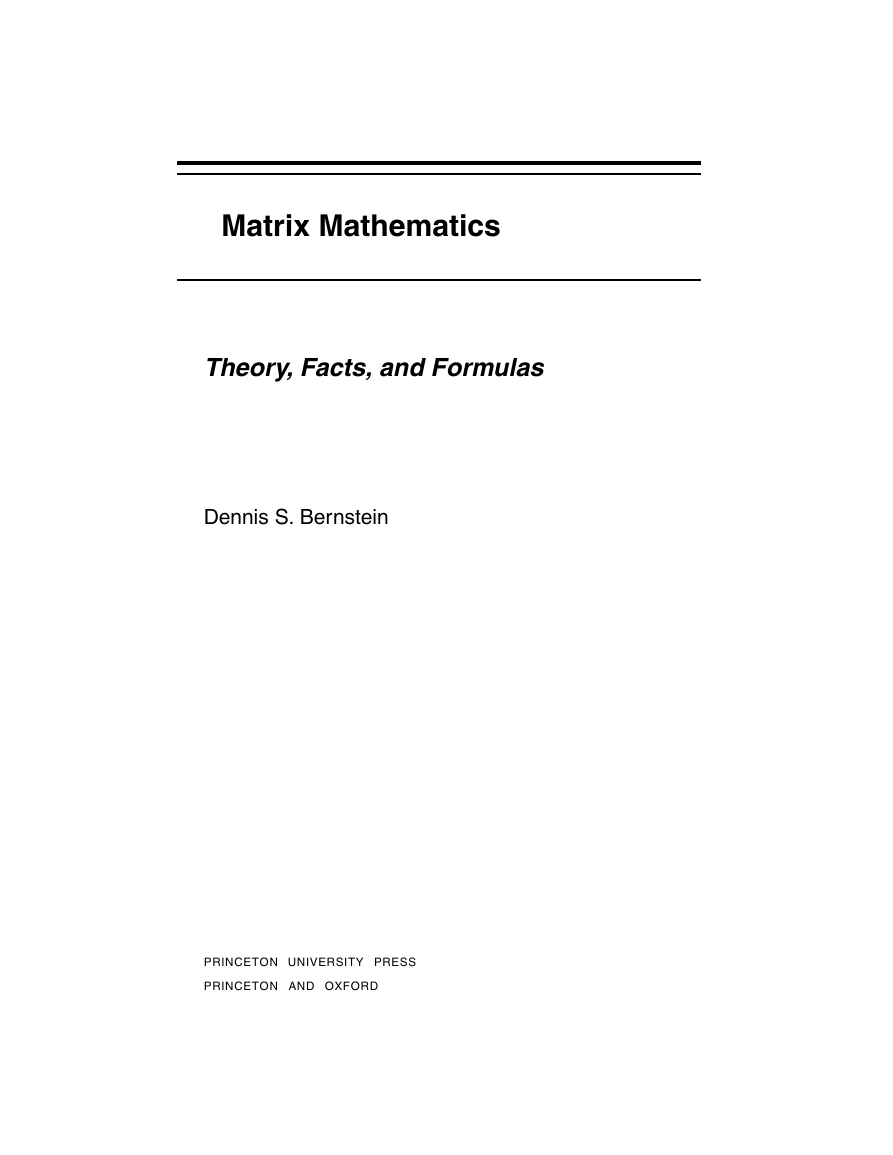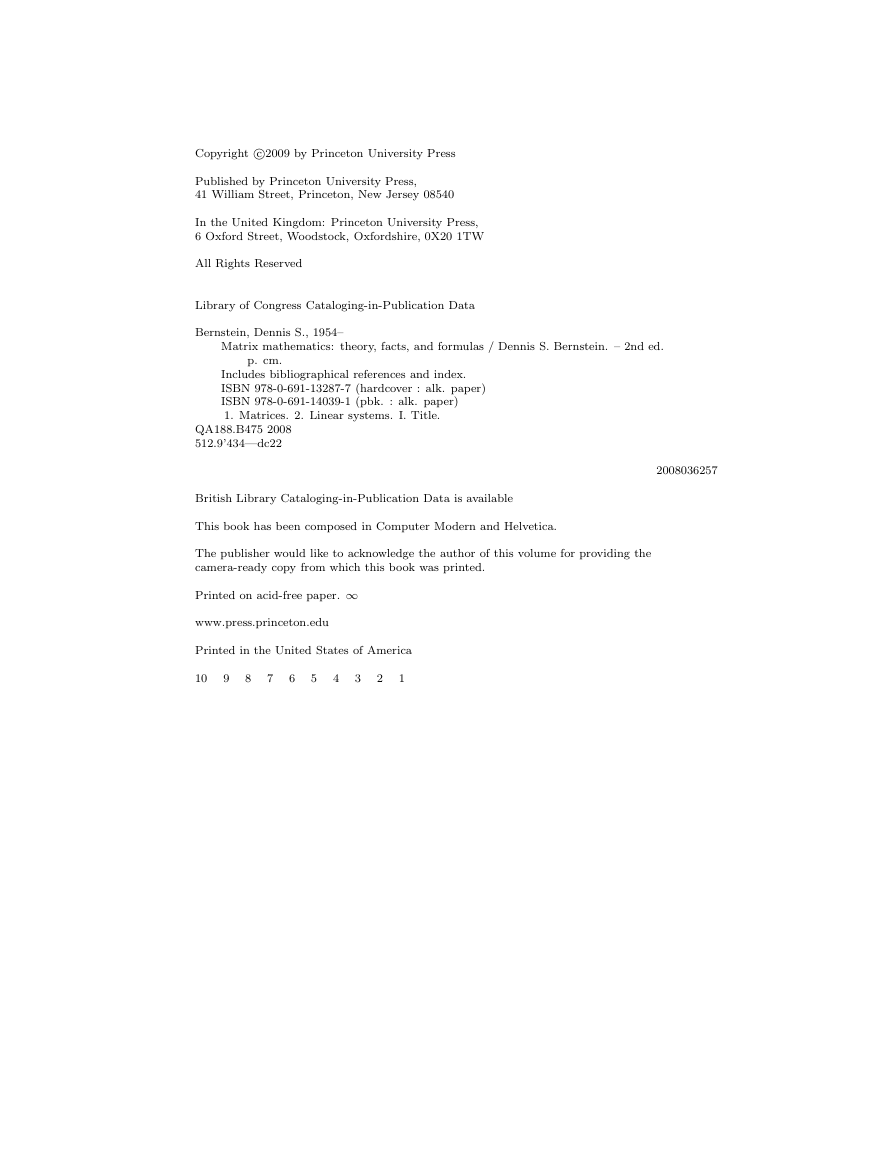MATRIX MATHEMATICS: THEORY, FACTS, AND FORMULAS, 2ND ED.
Title Page
Copyright Page
Dedication
Preface to the Second Edition
Preface to the First Edition
Special Symbols
Conventions, Notation, and Terminology
Chapter 1. Preliminaries
1.1 Logic and Sets
1.2 Functions
1.3 Relations
1.4 Graphs
1.5 Facts on Logic, Sets, Functions, and Relations
1.6 Facts on Graphs
1.7 Facts on Binomial Identities and Sums
1.8 Facts on Convex Functions
1.9 Facts on Scalar Identities and Inequalities in One Variable
1.10 Facts on Scalar Identities and Inequalities in Two Variables
1.11 Facts on Scalar Identities and Inequalities in Three Variables
1.12 Facts on Scalar Identities and Inequalities in Four Variables
1.13 Facts on Scalar Identities and Inequalities in Six Variables
1.14 Facts on Scalar Identities and Inequalities in Eight Variables
1.15 Facts on Scalar Identities and Inequalities in n Variables
1.16 Facts on Scalar Identities and Inequalities in 2n Variables
1.17 Facts on Scalar Identities and Inequalities in 3n Variables
1.18 Facts on Scalar Identities and Inequalities in Complex Variables
1.19 Facts on Trigonometric and Hyperbolic Identities
1.20 Notes
Chapter 2. Basic Matrix Properties
2.1 Matrix Algebra
2.2 Transpose and Inner Product
2.3 Convex Sets, Cones, and Subspaces
2.4 Range and Null Space
2.5 Rank and Defect
2.6 Invertibility
2.7 The Determinant
2.8 Partitioned Matrices
2.9 Facts on Polars, Cones, Dual Cones, Convex Hulls, and Subspaces
2.10 Facts on Range, Null Space, Rank, and Defect
2.11 Facts on the Range, Rank, Null Space, and Defect of Partitioned Matrices
2.12 Facts on the Inner Product, Outer Product, Trace, and Matrix Powers
2.13 Facts on the Determinant
2.14 Facts on the Determinant of Partitioned Matrices
2.15 Facts on Left and Right Inverses
2.16 Facts on the Adjugate and Inverses
2.17 Facts on the Inverse of Partitioned Matrices
2.18 Facts on Commutators
2.19 Facts on Complex Matrices
2.20 Facts on Geometry
2.21 Facts on Majorization
2.22 Notes
Chapter 3. Matrix Classes and Transformations
3.1 Matrix Classes
3.2 Matrices Based on Graphs
3.3 Lie Algebras and Groups
3.4 Matrix Transformations
3.5 Projectors, Idempotent Matrices, and Subspaces
3.6 Facts on Group-Invertible and Range-Hermitian Matrices
3.7 Facts on Normal, Hermitian, and Skew-Hermitian Matrices
3.8 Facts on Commutators
3.9 Facts on Linear Interpolation
3.10 Facts on the Cross Product
3.11 Facts on Unitary and Shifted-Unitary Matrices
3.12 Facts on Idempotent Matrices
3.13 Facts on Projectors
3.14 Facts on Reflectors
3.15 Facts on Involutory Matrices
3.16 Facts on Tripotent Matrices
3.17 Facts on Nilpotent Matrices
3.18 Facts on Hankel and Toeplitz Matrices
3.19 Facts on Hamiltonian and Symplectic Matrices
3.20 Facts on Miscellaneous Types of Matrices
3.21 Facts on Groups
3.22 Facts on Quaternions
3.23 Notes
Chapter 4. Polynomial Matrices and Rational Transfer Functions
4.1 Polynomials
4.2 Polynomial Matrices
4.3 The Smith Decomposition and Similarity Invariants
4.4 Eigenvalues
4.5 Eigenvectors
4.6 The Minimal Polynomial
4.7 Rational Transfer Functions and the Smith-McMillan Decomposition
4.8 Facts on Polynomials and Rational Functions
4.9 Facts on the Characteristic and Minimal Polynomials
4.10 Facts on the Spectrum
4.11 Facts on Graphs and Nonnegative Matrices
4.12 Notes
Chapter 5. Matrix Decompositions
5.1 Smith Form
5.2 Multicompanion Form
5.3 Hypercompanion Form and Jordan Form
5.4 Schur Decomposition
5.5 Eigenstructure Properties
5.6 Singular Value Decomposition
5.7 Pencils and the Kronecker Canonical Form
5.8 Facts on the Inertia
5.9 Facts on Matrix Transformations for One Matrix
5.10 Facts on Matrix Transformations for Two or More Matrices
5.11 Facts on Eigenvalues and Singular Values for One Matrix
5.12 Facts on Eigenvalues and Singular Values for Two or More Matrices
5.13 Facts on Matrix Pencils
5.14 Facts on Matrix Eigenstructure
5.15 Facts on Matrix Factorizations
5.16 Facts on Companion, Vandermonde, and Circulant Matrices
5.17 Facts on Simultaneous Transformations
5.18 Facts on the Polar Decomposition
5.19 Facts on Additive Decompositions
5.20 Notes
Chapter 6. Generalized Inverses
6.1 Moore-Penrose Generalized Inverse
6.2 Drazin Generalized Inverse
6.3 Facts on the Moore-Penrose Generalized Inverse for One Matrix
6.4 Facts on the Moore-Penrose Generalized Inverse for Two or More Matrices
6.5 Facts on the Moore-Penrose Generalized Inverse for Partitioned Matrices
6.6 Facts on the Drazin and Group Generalized Inverses
6.7 Notes
Chapter 7. Kronecker and Schur Algebra
7.1 Kronecker Product
7.2 Kronecker Sum and Linear Matrix Equations
7.3 Schur Product
7.4 Facts on the Kronecker Product
7.5 Facts on the Kronecker Sum
7.6 Facts on the Schur Product
7.7 Notes
Chapter 8. Positive-Semidefinite Matrices
8.1 Positive-Semidefinite and Positive-Definite Orderings
8.2 Submatrices
8.3 Simultaneous Diagonalization
8.4 Eigenvalue Inequalities
8.5 Exponential, Square Root, and Logarithm of Hermitian Matrices
8.6 Matrix Inequalities
8.7 Facts on Range and Rank
8.8 Facts on Structured Positive-Semidefinite Matrices
8.9 Facts on Identities and Inequalities for One Matrix
8.10 Facts on Identities and Inequalities for Two or More Matrices
8.11 Facts on Identities and Inequalities for Partitioned Matrices
8.12 Facts on the Trace
8.13 Facts on the Determinant
8.14 Facts on Convex Sets and Convex Functions
8.15 Facts on Quadratic Forms
8.16 Facts on Simultaneous Diagonalization
8.17 Facts on Eigenvalues and Singular Values for One Matrix
8.18 Facts on Eigenvalues and Singular Values for Two or More Matrices
8.19 Facts on Alternative Partial Orderings
8.20 Facts on Generalized Inverses
8.21 Facts on the Kronecker and Schur Products
8.22 Notes
Chapter 9. Norms
9.1 Vector Norms
9.2 Matrix Norms
9.3 Compatible Norms
9.4 Induced Norms
9.5 Induced Lower Bound
9.6 Singular Value Inequalities
9.7 Facts on Vector Norms
9.8 Facts on Matrix Norms for One Matrix
9.9 Facts on Matrix Norms for Two or More Matrices
9.10 Facts on Matrix Norms for Partitioned Matrices
9.11 Facts on Matrix Norms and Eigenvalues Involving One Matrix
9.12 Facts on Matrix Norms and Eigenvalues Involving Two or More Matrices
9.13 Facts on Matrix Norms and Singular Values for One Matrix
9.14 Facts on Matrix Norms and Singular Values for Two or More Matrices
9.15 Facts on Least Squares
9.16 Notes
Chapter 10. Functions of Matrices and Their Derivatives
10.1 Open Sets and Closed Sets
10.2 Limits
10.3 Continuity
10.4 Derivatives
10.5 Functions of a Matrix
10.6 Matrix Square Root and Matrix Sign Functions
10.7 Matrix Derivatives
10.8 Facts Involving One Set
10.9 Facts Involving Two or More Sets
10.10 Facts on Matrix Functions
10.11 Facts on Functions and Derivatives
10.12 Notes
Chapter 11. The Matrix Exponential and Stability Theory
11.1 Definition of the Matrix Exponential
11.2 Structure of the Matrix Exponential
11.3 Explicit Expressions
11.4 Matrix Logarithms
11.5 The Logarithm Function
11.6 Lie Groups
11.7 Lyapunov Stability Theory
11.8 Linear Stability Theory
11.9 The Lyapunov Equation
11.10 Discrete-Time Stability Theory
11.11 Facts on Matrix Exponential Formulas
11.12 Facts on the Matrix Sine and Cosine
11.13 Facts on the Matrix Exponential for One Matrix
11.14 Facts on the Matrix Exponential for Two or More Matrices
11.15 Facts on the Matrix Exponential and Eigenvalues, Singular Values, and Norms for One Matrix
11.16 Facts on the Matrix Exponential and Eigenvalues, Singular Values, and Norms for Two or More Matrices
11.17 Facts on Stable Polynomials
11.18 Facts on Stable Matrices
11.19 Facts on Almost Nonnegative Matrices
11.20 Facts on Discrete-Time-Stable Polynomials
11.21 Facts on Discrete-Time-Stable Matrices
11.22 Facts on Lie Groups
11.23 Facts on Subspace Decomposition
11.24 Notes
Chapter 12. Linear Systems and Control Theory
12.1 State Space and Transfer Function Models
12.2 Laplace Transform Analysis
12.3 The Unobservable Subspace and Observability
12.4 Observable Asymptotic Stability
12.5 Detectability
12.6 The Controllable Subspace and Controllability
12.7 Controllable Asymptotic Stability
12.8 Stabilizability
12.9 Realization Theory
12.10 Zeros
12.11 H2 System Norm
12.12 Harmonic Steady-State Response
12.13 System Interconnections
12.14 Standard Control Problem
12.15 Linear-Quadratic Control
12.16 Solutions of the Riccati Equation
12.17 The Stabilizing Solution of the Riccati Equation
12.18 The Maximal Solution of the Riccati Equation
12.19 Positive-Semidefinite and Positive-Definite Solutions of the Riccati Equation
12.20 Facts on Stability, Observability, and Controllability
12.21 Facts on the Lyapunov Equation and Inertia
12.22 Facts on Realizations and the H2 System Norm
12.23 Facts on the Riccati Equation
12.24 Notes
Bibliography
Author Index
Index
Back Cover
















 2023年江西萍乡中考道德与法治真题及答案.doc
2023年江西萍乡中考道德与法治真题及答案.doc 2012年重庆南川中考生物真题及答案.doc
2012年重庆南川中考生物真题及答案.doc 2013年江西师范大学地理学综合及文艺理论基础考研真题.doc
2013年江西师范大学地理学综合及文艺理论基础考研真题.doc 2020年四川甘孜小升初语文真题及答案I卷.doc
2020年四川甘孜小升初语文真题及答案I卷.doc 2020年注册岩土工程师专业基础考试真题及答案.doc
2020年注册岩土工程师专业基础考试真题及答案.doc 2023-2024学年福建省厦门市九年级上学期数学月考试题及答案.doc
2023-2024学年福建省厦门市九年级上学期数学月考试题及答案.doc 2021-2022学年辽宁省沈阳市大东区九年级上学期语文期末试题及答案.doc
2021-2022学年辽宁省沈阳市大东区九年级上学期语文期末试题及答案.doc 2022-2023学年北京东城区初三第一学期物理期末试卷及答案.doc
2022-2023学年北京东城区初三第一学期物理期末试卷及答案.doc 2018上半年江西教师资格初中地理学科知识与教学能力真题及答案.doc
2018上半年江西教师资格初中地理学科知识与教学能力真题及答案.doc 2012年河北国家公务员申论考试真题及答案-省级.doc
2012年河北国家公务员申论考试真题及答案-省级.doc 2020-2021学年江苏省扬州市江都区邵樊片九年级上学期数学第一次质量检测试题及答案.doc
2020-2021学年江苏省扬州市江都区邵樊片九年级上学期数学第一次质量检测试题及答案.doc 2022下半年黑龙江教师资格证中学综合素质真题及答案.doc
2022下半年黑龙江教师资格证中学综合素质真题及答案.doc